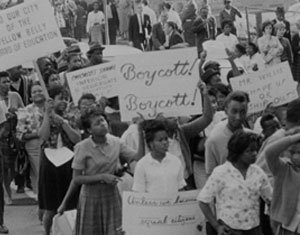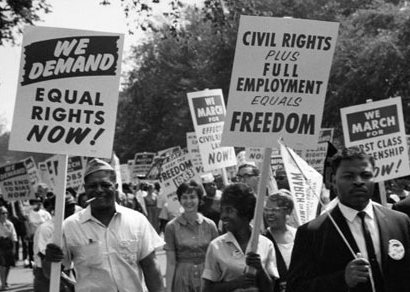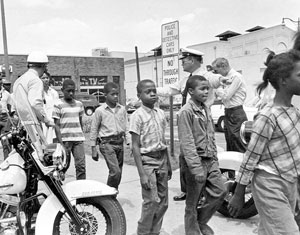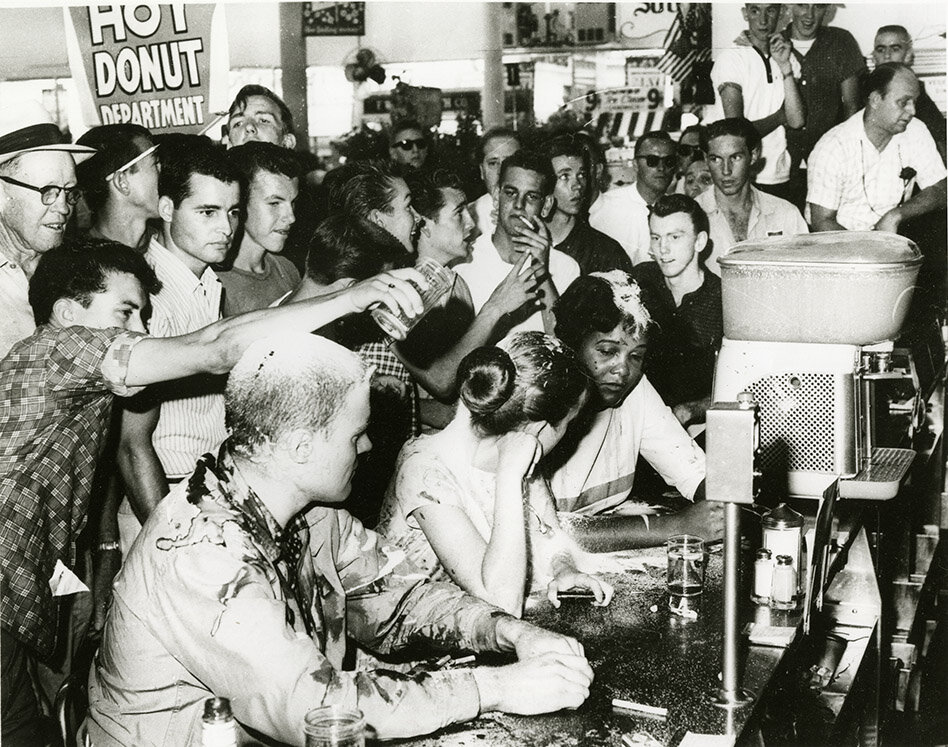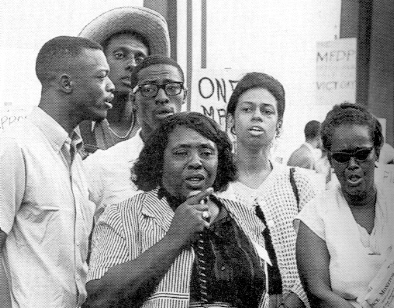Key Events in 1963 History
Reading by Julian Hipkins III and Deborah Menkart
The year 1963 was pivotal to the modern Civil Rights Movement. It is often recalled as the year of the March on Washington, but much more transpired. It was a year dedicated to direct action and voter registration and punctuated by moments of political theater and acts of violence.
To support teaching about 1963 events, we describe here some of the key events and milestones in the Movement. Where possible we list recommended books, primary documents, films, and articles for learning more. Key among those resources is the Civil Rights Movement Veterans website, a rich repository of documents, photos, oral histories, audio clips, and other resources created and maintained by those who worked on the front lines of the freedom struggle.
Key Events in 1963
THE CHILDREN’S CRUSADE
(BIRMINGHAM, ALABAMA)
In early April, convinced that only national legislation is capable of eliminating legal, institutional segregation, Movement strategists embark on a campaign designed to break the practice in one of its toughest strongholds — Birmingham — and to garner enough national attention in the process that the Kennedy administration will be compelled to draft and champion a comprehensive civil rights bill.
After issuing the Birmingham Manifesto on April 3 and enacting a Good Friday march that lands Rev. Dr. Martin Luther King, Jr. in the cell where he will pen “Letter from Birmingham Jail,” the campaign focuses on involving the city’s high school students. Their arrest promises less economic devastation to families and their age guarantees national visibility and outrage.
On “D-Day” (May 2), 1,000 students “ditch” classes to march two-by-two out of 16th Street Baptist Church and endure arrest. In the following days, thousands more students are knocked off their feet by high-pressure water hoses, menaced by police dogs and angry whites, and incarcerated in improvised jails at the county fairgrounds. On the seventh day, city officials agree to negotiate with the Black community, and on May 9, a tentative agreement to end segregation in Birmingham is reached.
(Learn more in the classroom-friendly film Mighty Times: The Children’s March, the middle school book We’ve Got a Job: The 1963 Birmingham Children’s March, and the website Kids in Birmingham: 1963.)
THE “MAILMAN MURDER” – THE DEATH OF WILLIAM MOORE (GADSDEN, ALABAMA)
As a way of demonstrating support for ending segregation and solidarity with Movement activists, U.S. postal worker William Moore – member of the Baltimore chapter of Congress of Racial Equality (CORE), and former U.S. Marine – embarks on April 20th upon a solo freedom journey from Chattanooga, Tennessee, to Jackson, Mississippi.
Moore stops at the White House first, in hopes of informing President Kennedy that he plans to hand-deliver his own letter, a letter in support of integration, to Mississippi Gov. Ross Barnett at the conclusion of his march.
Moore is not granted a meeting in Washington, but his walk attracts attention: pushing his gear in a postal handcart, Moore wears sandwich-board signs reading: “End Segregation in America” and “Eat at Joe’s‑‑Black and White.” His body is discovered on April 23 by the side of U.S. Highway 11, in Attalla, Alabama (near Gadsden) with two bullets in his head. Two groups of Movement workers seek to complete Moore’s march but are arrested in the process.
(Learn more in “A Postman’s 1963 Walk For Justice, Cut Short On An Alabama Road” by Miles Johnson on NPR, August, 2013.)
WOOLWORTH’S SIT-IN
(JACKSON, MISSISSIPPI)
After an ongoing boycott of white-owned stores proves incapable of breaking segregation, student activists trained in nonviolence sit-in at Woolworth’s lunch counter in downtown Jackson on May 28, 1963.
John Salter, Joan Trumpauer, and Anne Moody sit in at the downtown Woolworth’s in Jackson, Miss. They are surrounded by a mob who poured condiments on them. Photo: Fred Blackwell, Erle E. Johnston Papers, University of Southern Mississippi Libraries
They are surrounded by a mob of whites who curse them, punch them, kick them, and douse them with mustard, ketchup, and sugar. The direct action gives rise to mass meetings, mass marches, mass arrests, and an iconic photograph of the protestors. They included Anne Moody, whose autobiography Coming of Age in Mississippi would become a classic text of the times. Learn more.
POLICE BRUTALITY IN WINONA JAIL
(WINONA, MISSISSIPPI)
Movement activists from the Delta returning from Citizenship School training in South Carolina are arrested after they attempt to eat at a bus depot’s white lunch counter on June 9. They are taken to an isolated jail in Winona, Mississippi, where they are brutally beaten. Among the group are three local teenagers, SCLC organizer Annell Ponder, SNCC field secretary Lawrence Guyot, and former sharecropper and voting rights worker Fannie Lou Hamer, who suffers permanent damage from the attack. The incident draws national public attention to the campaign for voting rights. Learn more.
THE STAND IN THE SCHOOLHOUSE DOOR
(TUSCALOOSA, ALABAMA)
Following Gov. George W. Wallace’s 1962 campaign promise to defend segregation at all costs, “…to the point of standing in the schoolhouse door, if necessary,” he does just that on June 11, when three black students — Vivian Malone of Mobile, James Hood of Gadsden, and Dave McGlathery of Huntsville — arrive to register at the University of Alabama.
Given that a federal injunction virtually guaranteed their admission, Wallace’s stonewalling stunt is largely for the benefit of waiting television news cameras and in consideration of his political prospects.
The students’ historic admission followed Autherine Lucy’s unsuccessful 1956 attempt to desegregate the University.
JOHN F. KENNEDY’S CIVIL RIGHTS SPEECH
(WASHINGTON, D.C.)
On the evening of June 11, following Gov. Wallace’s infamous stand in the schoolhouse door, President Kennedy addresses the nation on the issue of civil rights, for the first time roundly condemning segregation and announcing his intention to submit a comprehensive civil rights bill to Congress.
ASSASSINATION OF MEDGAR EVERS
(JACKSON, MISSISSIPPI)
Returning home after a late meeting following President Kennedy’s national address on civil rights, NAACP state field director Medgar Evers is murdered in his driveway in the early hours of June 12, shot at close range with a high-powered rifle by white supremacist Byron De La Beckwith of Greenwood. His two children and wife Myrlie witness his death. A key figure in the Jackson Movement and in the desegregation of the University of Mississippi, Evers had worked tirelessly to sustain the Movement since 1952, the year he and his wife began organizing NAACP chapters in the Mississippi Delta.
Learn more in the introductory lesson for middle and high school students called Meet Medgar Evers.
CLYDE KENNARD’S FREEDOM AND DEATH
Clyde Kennard, a WWII veteran, returned to his home of Eatonville, Mississippi to help the family farm. Kennard had finished the first three years of his political science degree in Chicago and intended to transfer to a University in Mississippi to complete his degree. There were no Black colleges in southern Mississippi in the 1950s, so Kennard applied to Mississippi Southern College, now the University of Southern Mississippi, in Hattiesburg. Between 1955 and 1959, Clyde Kennard applied three times to the Mississippi Southern College. He was denied admission every time on a series of technicalities. Kennard had no intention of silently giving up on his education. He wrote of his attempts to gain admission to the College in a letter to the local newspaper, the Hattiesburg American.
In September of 1960, Kennard was arrested and tried on the fabricated charges of stealing $25 worth of chicken feed from the Forrest County Cooperative. In just ten minutes an all-white jury found Kennard guilty and sentenced him to seven years in prison. During his incarceration Kennard was forced to work at the notorious Parchman Prison’s cotton plantation. Within a year Kennard was unable to work due to intense pain and was hospitalized where it was discovered that he had cancer. After doctors notified him that he was unlikely to live much longer, friends, family members, and supporters led a campaign for his release. In February of 1963, he was released and flown to Chicago where he died on July 4, 1963.
Learn more in “Clyde Kennard: A Little-Known Civil Rights Pioneer” on the Mississippi History Now website, various posts on the CRMvets site, and on the Zinn Education Project website where you can find a portrait and the letters Kennard wrote.
THE MARCH ON WASHINGTON FOR JOBS AND FREEDOM
(WASHINGTON, D.C.)
Following President Kennedy’s civil rights address in June, SCLC leaders plan a mass action of national scale designed to ensure passage of civil rights legislation. Drawing together tens of thousands of Movement allies from across the nation – workers with SNCC, CORE, NAACP, and SCLC, as well as members of labor unions, interdenominational organizations, and student groups—the August 28 march from the Washington monument to the Lincoln memorial is the largest demonstration of its kind in history. The turnout was a testament to the organizational savvy of Bayard Rustin (who steered the event from idea to reality in a scant six weeks) and to the vision of Movement senior statesman A. Philip Randolph, who had dreamt of such a march for years.
Arriving by special trains, private aircraft, automobiles, and more than 2,000 chartered buses, the marchers found the nation’s capital prepared for chaos and violence –neither of which occurs.
Speakers included A. Philip Randolph, Bayard Rustin (who introduced Daisy Bates, Diane Nash, Prince E. Lee, Rosa Parks, and Gloria Richardson), John Lewis, Walter Reuther, Floyd McKissick, Whitney Young, Roy Wilkins, and Martin Luther King, Jr. The event closed with Rustin reading the march’s official demands and a benediction by Morehouse College president Benjamin Mays.
BOMBING OF 16TH STREET BAPTIST CHURCH
(BIRMINGHAM, ALABAMA)
The four girls killed during the 16th Street Baptist Church bombing. From left, Denise McNair, 11; Carole Robertson, 14; Addie Mae Collins, 14; and Cynthia Wesley, 14.
On September 15, less than three weeks after the March on Washington for Jobs and Freedom, a dynamite bomb planted by Klansmen explodes inside 16th Street Baptist Church, killing four young girls: Addie Mae Collins (14), Denise McNair (11), Carole Robertson (14), and Cynthia Wesley (14). More than 20 others are injured in the attack, timed to occur during a “Youth Day” tribute to the part of local young people in the Birmingham Campaign.
It is the city’s 28th racial bombing. Justice in the case, recounted in Spike Lee’s 1997 film “4 Little Girls” comes only much later. After the FBI provides long-concealed evidence, Robert Chambliss is convicted of murder in 1977; Thomas Blanton in 2001; and, Bobby Frank Cherry, in 2002. (The fourth bomber, Herman Cash, died in 1994 without ever being indicted.)
FREE SOUTHERN THEATER
SNCC members John O’Neal and Doris Derby join actor/journalist Gilbert Moses and thespians at Tougaloo College to form the Drama Workshop at Tougaloo College in October, which grows into the Free Southern Theater (FST). Racially integrated and dedicated to social change, the FST takes live theater to poor, rural, mostly Black audiences across Mississippi Louisiana, Tennessee, and Georgia. Refusing to play to segregated audiences, the FST’s Freedom Summer Tour stages free performances of In White America, Purlie Victorious, Waiting for Godot, and others in churches and improvised community spaces. Acclaimed artists Harry Belafonte, Langston Hughes, Ossie Davis, Ruby Dee, James Baldwin, Loraine Hansberry, Sidney Poitier, Theodore Bikel, and Lincoln Kirstein support the project. Learn more.
CHICAGO SCHOOL BOYCOTT
(CHICAGO, ILLINOIS)
In the aftermath of the Brown v. Board of Education Supreme Court ruling, Chicago’s schools were overcrowded and underfunded, and the Chicago Board of Education refused to allow Black students to transfer to white schools. The Chicago Board disregarded the Brown ruling to integrate schools by claiming they were following a neighborhood schools policy that required students to attend a school if it was within walking distance of their home.
In response to overcrowding, the Board of Education brought in mobile classrooms, which community members referred to as “Willis Wagons,” after the head of the Board of Education, Benjamin C. Willis. The board claimed these were temporary solutions, but for many of Chicago’s Black residents, they were endemic of the racial inequality in schooling.
The movement against segregation and inequality in schools had been going on for years, but climaxed on October 22, 1963, when over 200,000 Chicago students boycotted school as part of “Freedom Day.” Additionally, at least 10,000 students, parents, and community members protested outside the headquarters of the Chicago Board of Education. Some signs read “Willis Must Go,” or “No Willis Wagons,” while others demanded integrated schools. While there wasn’t a clear-cut victory, the Board of Education felt the pressure and agreed to increase the number of Black students who could transfer to white schools. Community members kept organizing after the successful 1963 boycott, even organizing another school boycott in 1965 in which 100,000 students boycotted classes. Read more at the Zinn Education Project.
For more information visit the Chicago History Museum’s Facing Freedom site or visit the documentary project ’63 Boycott.
MALCOLM X SPEECH: MESSAGE TO THE GRASS ROOTS
Like members of the Black Panther Party for Self-Defense, Malcolm X advocated for the right of armed self-defense for Black and other oppressed groups who lived in so violently a racist society as the United States.
On November 10, 1963, Malcolm X delivered what is considered by many to be one of the most important speeches of the 20th century, “Message to the Grass Roots,” at the Northern Negro Grass Roots Leadership Conference in Detroit.
You can listen to Mos Def read an excerpt from the speech in a Voices of a People’s History of the United States recording.
FREEDOM BALLOT — OR “FREEDOM VOTE”
(MISSISSIPPI)
In a radical challenge to the concept of voter “qualification” (which in Mississippi required prospective voters to pass an arcane literacy test), the Student Nonviolent Coordinating Committee holds an unofficial statewide “Freedom Ballot” based on the principle of “One Man, One Vote.” Designed to demonstrate that large numbers of Black people will vote when afforded the right to do so, the event draws more than 80,000 people, who defy white intimidation to cast ballots. The Freedom Ballot lays the foundation for the Mississippi Freedom Democratic Party, which will challenge the Democratic Convention in Atlantic City, New Jersey the next year.
Generally speaking, the struggle for the vote distinguished the entire year. In Greenwood, local blacks angered over a food blockade by white officials and incensed over the repeated arrest of SNCC field secretary Sam Block stage the city’s first mass protest on the date of his trial. The protest inspires a mass meeting of 250 people, the largest to date. Soon local African Americans who once feared being seen with Movement workers repeatedly brave police dogs, club-wielding cops, and economic reprisal in the attempt to register to vote. By year’s end, some 1,500 African Americans have attempted to register. The local Movement burgeons, and voter registration efforts expand into surrounding Delta counties. Corresponding drives take place in Laurel, Meridian, Hattiesburg, Holly Springs, and Vicksburg.
Hartman Turnbow. Photo by Sue Sojourner from “Thunder of Freedom.”
In Holmes County, farmer Hartman Turnbow is one of the first African Americans to register to vote since the end of Reconstruction. After he leads 12 others to the county registrar, Klan nightriders firebomb his house.
In Sunflower County, sharecropper Fannie Lou Hamer is fired from her job and evicted from her home after she and 20 others attempt to register to vote. It sparks her lifelong commitment to the Movement.
In Itta Bena, 150 African Americans respond to the assassination of Medgar Evers with a memorial voter registration mass meeting which is tear-gassed by Klansmen. Singing freedom songs, the people immediately march to the town hall, where 45 are arrested, given a five-minute “trial” and sent to the Leflore County prison farm. A week later, 200 African Americans show up at the courthouse to attempt to register; many are sent to the prison farm. To dramatize the struggle for the vote, SNCC targets the all-white Democratic Primary, preparing local people to show up at the polls and demand the provisional ballots afforded citizens illegally prevented from voting. On August 6, nearly 1,000 Black people across the state cast provisional ballots.

